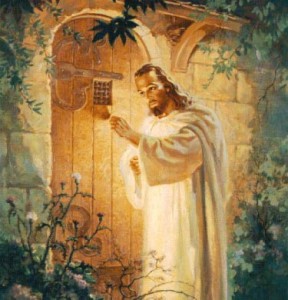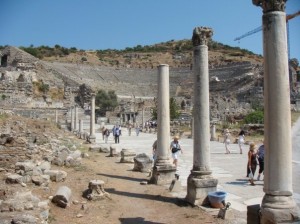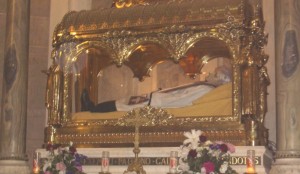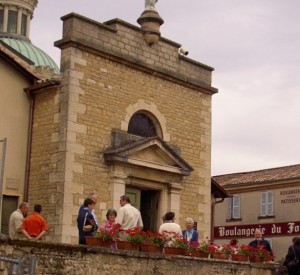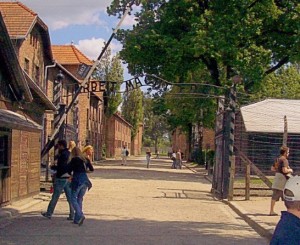
The infamous Auschwitz gate, taken during a pilgrimage in 2005.
(c) 2012 The Catholic Counselor Lady
This week has two different feast days of saints who had died in the Nazi Concentration Camp at Auschwitz. One on August 9, is for St. Benedicta of the Cross, a Carmelite; and the other on August 14 is for St. Maximilian Kolbe, a Conventual Franciscan.
St. Benedicta of the Cross
St. Benedicta of the Cross, otherwise known as Edith Stein, was born on October 10, 1892 in Breslau, Germany. Jewish by birth, at the age of 14 she declared herself an atheist. Having a brilliant mind, she first studied German, history, women’s issues of her day, and then pursued philosophy. She earned a doctorate in philosophy summa cum laude from the University of Freiburg in 1917. Her dissertation was entitled, “The Problem of Empathy.” She became a teaching assistant to Edmund Husserl, a phenomenologist, and wrote articles on the philosophical foundations of psychology. In spite of her desire for a professorship, as a woman she was prohibited and was further refused on account of her Jewish background.
In her search for truth, Edith found the mystical autobiography of St. Teresa of Avila which she read in one night. This discovery led to her conversion to the Catholic Church with her baptism on New Year’s Day in 1922. She stated, “”I had given up practicing my Jewish religion when I was a 14-year-old girl and did not begin to feel Jewish again until I had returned to God.” She had felt that she was connected to Christ not only spiritually but also through her blood (obtained from vatican.va). She immediately desired to become a Carmelite nun. But under spiritual direction she was advised to take teaching positions at schools for religious, was an extensive speaker on women’s issues, was a prolific writer, and translated works by Cardinal Neumann and Thomas Aquinas. At this point of her life she strived to combine scholarship with her faith. She stated, “If anyone comes to me, I want to lead them to Him.” Although she was very learned and profound, she remained very practical and in touch with everyday life.
After Nazi Germany banned her from teaching, she entered the Carmelite Convent in Cologne. Edith Stein took on the name St. Benedicta of the Cross, making her eternal profession on April 21, 1938. As Nazi terrorism spread throughout Europe, Edith Stein was smuggled across the border to Echt, Netherlands. Her sister, Rosa, had also converted to Catholicism and had joined the same convent. In 1942 Edith Stein, Rosa, and other members of the convent while at prayer in a chapel were arrested by the Gestapo. She was last heard to say to her sister as she left Echt, “Come, we are going for our people.”
She died in the gas chambers at within days of reaching Auschwitz on August 9, 1942.
St. Maximilian Maria Kolbe
St. Maximilian Kolbe was born Raymund Kolbe on January 8, 1894 in Russian-occupied Poland. His parents were very devout Roman Catholics. He was noted to be a very mischievous as a boy but his mother noted that he spent many hours at the altar of Our Lady of Czestochowa praying and crying. During his childhood he had a vision of the Blessed Virgin Mary where she asked him to choose between two crowns: A white one for purity, and a red one for martyrdom. He responded by requesting to receive both.
St. Maximilian became a Conventual Franciscan as a priest friar. Having an aptitude for studies, he had obtained doctorates both in philosophy and theology. As a friar he established the Militia Immaculata movement, or “Army of Mary” where he worked for the conversion of sinners and to establish fervent devotion to the Blessed Virgin Mary around the world. This included the wearing of the Miraculous Medal as a sign of this devotion and promoted consecration to Jesus through Mary.
He founded the monastery of Niepokalanów or “Marytown” near Warsaw which became a major publishing center and radio station. This friary grew to over 800 men. Through the media he spoke out against the atrocities of the Nazi regime and promoted his Catholic faith. Fr. Kolbe became director of Poland’s chief Catholic publishing complex, which published both a monthly magazine, “The Knight of the Immaculata” with a circulation of about one million and a daily paper with a circulation of about 125,000. He also was a missionary to Japan, establishing another “Marytown” near Nagasaki. He also went to India.
As St. Maximilian Kolbe grew older, his health, which had never been very strong, became worse . He had contracted tuberculosis, suffered from violent headaches, and had been covered with abscesses. He even spent some time in a sanitarium but never achieved full recovery.
During the Nazi occupation of Poland, Fr. Kolbe hid refuges in the monastery at Niepokalanów. It was just a matter of time before the Gestapo rounded up St. Maximilian along with many of his fellow friars in 1941.
He was transferred to Auschwitz. After three prisoners had escaped from the camp, the guards selected ten inmates to die in retribution. St. Maximilian Kolbe volunteered to take the place of a man who had a wife and children. The ten were taken to an underground bunker where they were starved to death. Fr. Kolbe led the others in prayer and singing during their ordeal. After two weeks with no food or water, St. Maximilian was the only one still alive. The guards ended his life by giving him a lethal injection of carbolic acid. St. Maximilian was cremated on August 15, the feast of the Assumption of the Blessed Virgin Mary.
My connection to these saints of Auschwitz
My family and I visited the grounds of Auschwitz and adjoining prison camp of Birkenau on a pilgrimage in 2005. My memory is filled with the solemnity of the place. I remember standing on the infamous train platform being overcome by a sudden drop in my blood sugar and breaking out in a cold sweat. My time was interrupted, and in a frantic effort to prevent myself from fainting, I sought out a package of nabs in an adjoining snack shop. As I stood there scarfing down my crackers, I was hit with the realization that none of the passengers had such a convenience when they met their deaths here decades ago.
Later I remember seeing Pope Benedict XVI visit the same location during thunderstorms at which time a rainbow appeared during the television broadcast above the markers dedicated to the many who had lost their lives there. To me it was quite miraculous that the dark clouds had departed at the point of the Holy Father’s visit. I was at a loss to note that to my knowledge no mention of the rainbow during the Pope’s visit ever appeared on the major news networks.
When my family moved to the Chicago area in 2011, I discovered the National Shrine of St. Maximilian Kolbe at Marytown which happened to be down the road from my home in Libertyville. Upon my conversion to the Catholic Church, my family and I became members of the Militia Immaculata which involves consecration to Jesus through Mary. The Conventual Franciscan at Marytown still carry out the mission of St. Maximilian Kolbe of increasing devotion to the Blessed Virgin Mary.
Our connection to St. Benedict of the Cross and St. Maximilian Kolbe
These two deaths were not sudden last minute acts of heroism. Their whole lives prepared them for the sacrifices that they made. Their work helped others– especially strangers, and continues to influence us today. The Gospel states: “greater love than this no man has that a man lay down his life for his friends.“
According to St. Benedicta of the Cross: “Whatever did not fit in with my plan did lie within the plan of God. I have an ever deeper and firmer belief that nothing is merely an accident when seen in the light of God, that my whole life down to the smallest details has been marked out for me in the plan of Divine Providence and has a completely coherent meaning in God’s all-seeing eyes. And so I am beginning to rejoice in the light of glory wherein this meaning will be unveiled to me.”
Their lives speak of abandonment to the will of God. Their lives speak of sacrifice out of love for God and others.

Auschwitz. (c) 2012 The Catholic Counselor Lady

St. Maximilian Kolbe’s cell at Auschwitz.
(c) 2012 The Catholic Counselor Lady

